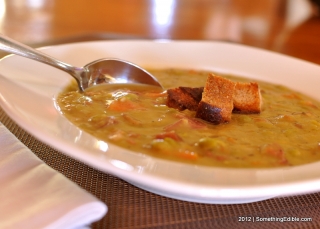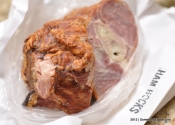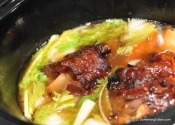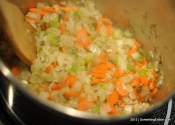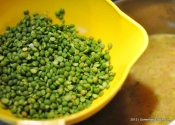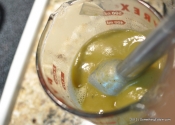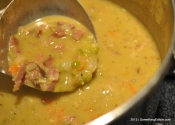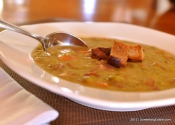Some food, some drink.
Ham Hock Stock and Homemade Split Pea Soup.
Abstract:
Ok, when was the last time you had a brimming, hot bowl of split pea soup? Alright, now everyone that gets their split pea soup from a can please put your hand down. Wow, not many left huh? Well, that's a shame because homemade split pea soup is a real treat. It's not at all difficult to prepare; but cooking the right ingredients the right way swaps out "just ok" for descriptors like "hearty," satisfying," and "fantastic". The way I do split pea soup means starting with a slow cooker stock based on smoky pork hocks originating from locally-raised pork. Fresh veggies sweat in butter and herbs make for the kind of savory foundation where a half pound of dry legumes can't help but end up being tasty.
Purpose:
For me soup is a little bit like jazz. It's made a little different every time; and while a recipe, like sheet music is sufficient to carry the tune, a recipe doesn't really shine until a guy puts down his notes and starts to wing it. So while this isn't exactly the first time I've made this recipe, it is the first time I've made this recipe in this specific fashion, so you'll have to forgive me if you were looking for a bit more predictability (anyhow, we had a proper beta recipe last week, people).
Much like potato soup, a lot of what makes split pea soup work so well hinges on said soup's consistency. The best way to hose up a soup is to throw it all in the pot, turn up the burner, and cross your fingers. I know there are Crock Pot recipes for s.p.s.; and I've got nothing against slow cooker soup. However, for this here soup, I really don't dig a straight slow cooker method and that "cruise-control cooking". Dried legumes on thier own can be overwhelmingly earthy and as they begin to break down in the simmer, they have the potential to really muddy up a soup. To remedy this problem, we need to add flavors in layers and at different times to ensure that ingredients retain their identity, so that eyes and tastebuds alike can enjoy and understand what's going on in every spoonful.
Recipe: Jump to the detailed recipe. (or, keep reading for the gist of it) -
Ham Hock Stock
The Soup Proper
For the Stock-
Add the water and the hocks to an appropriately-sized slow cooker. Set the heat to low, cove, and let it go for 6 hours. Add onion, carrots, and celery and continue cooking on low for 2 more hours. At the end of the slow cook, reserve the pork hocks and strain the rest to separate the worn-out veggies (discard 'em). Cool to room temperature and refrigerate the stock until you're ready to make soup (or move directly on to the next step if you can't wait).
For the Soup-
Into a 4 quart pot over medium heat, melt the butter and add the onion, carrots, celery, garlic, salt, thyme, sage, black pepper, and cayenne. Sweat for 10 minutes stirring occassionally to prevent any burning. When the onion gets translucent, and the carrots start to get tender , add the ham stock and the dried, rinsed split peas. Still over medium heat, bring the proto-soup just to a boil. Cover, reduce heat to low, and simmer for 30-35 minutes or until peas are just tender.
Ladle out 2 cups worth of soup and blend the reserved soup until smooth. Stir the blended soup back into the pot. Dice up the pork hocks reserved from the stock-making and add that to the soup along with the sour cream and Balsamic vinegar to finish.
Observation:
- If the stock method seems a bit familiar here, that's cuz it's exactly the way I make slow cooker turkey stock (if it ain't broke, don't fix it).
- In most cases, my carrot eating hound gets a treat more to her liking when I make stock. Along with all that prize gelatin, Animal protein tends to give up all its flavor for the stock cause, and all that's left is better off left as dog fodder. However, in the case of smoked pork hocks, what's been stewed into oblivion has even more to give. The 8ish hour hot soak makes that impossibly tough cut of hog manageable; and what's more, the meat still tastes like something you'd wanna eat. Waste not, want not people.
- Oh you hoity-toity food folks and your fancy gadgets: Who the hell has a stick blender? Well if you consider yourself a soup person, this question is a bit rhetorical. Soup is all about texture and there's no better way to control the texture of a soup than by a bit of blending. Reserve two cups of soup and hit it with the stick until it's smooth. One caveat here: Make sure any blendage is done before you add the pork bits back to the mix (that'd be nasty).
- Besides the obvious addition of salt, soups that are "missing something" lack the brightness that comes from the addition of something acidic. A splash of vinegar will do wonders for a soup; and in this instance, we're also using sour cream for an extra bit of richness as well. The next time you're tempted to add more salt to a soup, you might wanna see what dinking with the pH a bit first before serving will get ya.
Results:
If I was gonna pick just one soup to eat for the rest of my life, split pea soup would likely be in my top three choices. Soup is very much a textural affair for me, and because we judiciously blended we have balance; not real soupy, but not a thick, chunky mess either. Likewise, because we used stock to start, we've got plenty of body without having to go overboard with the dairy.
If you had to boil it down, I divide my soups into two camps: Stock based-soups, and everything else. Stock-based soups come together pretty quickly if you don't include that extra preliminary step of making stock. Stock-making takes the better part of a business day, but there's nothing to say that you have to do this all in one fail swoop either. Do your stock on a day where you have time to mind the crock pot for those few crucial hours near the end of the cook and you'll have the basis for a bowl of perfectly-seasoned legume and hog goodness later in the week when dinner needs to happen with relative quickness.
Gallery:
It's real easy: If the guy processing your hog asks you if you want the hocks smoked, you say "yes."
It's real easy: If the guy processing your hog asks you if you want the hocks smoked, you say "yes."
The trick to great stock is to add your veggies at the very end. On an eight hour cook, the aromatics only need to be present for the last couple of hours.
The trick to great stock is to add your veggies at the very end. On an eight hour cook, the aromatics only need to be present for the last couple of hours.
A sweat of carrots, celery, and onions. Yup; that's a mirepoix.
A sweat of carrots, celery, and onions. Yup; that's a mirepoix.
I'm not much for geophagia, so I make sure to rinse my split peas before adding them to the soup.
I'm not much for geophagia, so I make sure to rinse my split peas before adding them to the soup.
No need for extra thickeners, all your soup needs can be released by blending 2 cups of reserved soup (who knew?).
No need for extra thickeners, all your soup needs can be released by blending 2 cups of reserved soup (who knew?).
With the consistency corrected, the diced bits of ham hock are added back to the soup. Grab me a bowl.
With the consistency corrected, the diced bits of ham hock are added back to the soup. Grab me a bowl.
Get Social
Please wait while my tweets load...
Get the latest recipes and news. Join our Facebook page!



